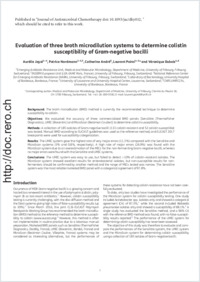Evaluation of three broth microdilution systems to determine colistin susceptibility of Gram-negative bacilli
- Jayol, Aurélie Emerging Antibiotic Resistance Unit, Department of Medicine, University of Fribourg, Switzerl - INSERM European Unit, University of Fribourg, Switzerland - National Reference Center for Emerging Antibiotic Resistance (NARA), University of Fribourg, Switzerland - Laboratory of Bacteriology, University Hospital of Bordeaux, France
- Nordmann, Patrice Emerging Antibiotic Resistance Unit, Department of Medicine, University of Fribourg, Switzerl - INSERM European Unit, University of Fribourg, Switzerland - National Reference Center for Emerging Antibiotic Resistance (NARA), University of Fribourg, Switzerland - University of Lausanne and University Hospital Center, Switzerland
- André, Catherine CNRS UMR5234, University of Bordeaux, France
- Poirel, Laurent Emerging Antibiotic Resistance Unit, Department of Medicine, University of Fribourg, Switzerl - INSERM European Unit, University of Fribourg, Switzerland - National Reference Center for Emerging Antibiotic Resistance (NARA), University of Fribourg, Switzerland
- Dubois, Véronique Laboratory of Bacteriology, University Hospital of Bordeaux, France - CNRS UMR5234, University of Bordeaux, France
-
2018
Published in:
- Journal of Antimicrobial Chemotherapy. - 2018, vol. 73, no. 5, p. 1272-1278
English
The broth microdilution (BMD) method is currently the recommended technique to determine susceptibility to colistin.Objectives: We evaluated the accuracy of three commercialized BMD panels [Sensititre (ThermoFisher Diagnostics), UMIC (Biocentric) and MicroScan (Beckman Coulter)] to determine colistin susceptibility.Methods: A collection of 185 isolates of Gram-negative bacilli (133 colistin resistant and 52 colistin susceptible) was tested. Manual BMD according to EUCAST guidelines was used as the reference method, and EUCAST 2017 breakpoints were used for susceptibility categorization.Results:The UMIC system gave the highest rate of very major errors (11.3%) compared with the Sensititre and MicroScan systems (3% and 0.8%, respectively). A high rate of major errors (26.9%) was found with the MicroScan system due to an overestimation of the MICs for the non-fermenting Gram-negative bacilli, whereas no major errors were found with the Sensititre and UMIC systems.Conclusions: The UMIC system was easy to use, but failed to detect >10% of colistin-resistant isolates. The MicroScan system showed excellent results for enterobacterial isolates, but non-susceptible results for non- fermenters should be confirmed by another method and the range of MICs tested was narrow. The Sensititre system was the most reliable marketed BMD panel with a categorical agreement of 97.8%.
- Faculty
- Faculté des sciences et de médecine
- Department
- Médecine 3ème année
- Language
-
- English
- Classification
- Biological sciences
- License
-
License undefined
- Identifiers
-
- RERO DOC 309054
- DOI 10.1093/jac/dky012
- Persistent URL
- https://folia.unifr.ch/unifr/documents/306588
Statistics
Document views: 93
File downloads:
- pdf: 170
